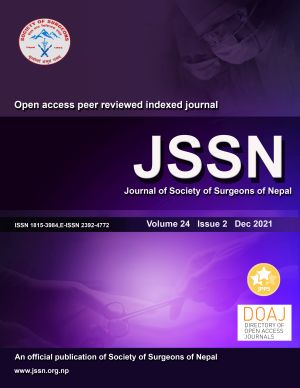Our experience of scalp reconstruction in a tertiary care centre of Nepal
DOI:
https://doi.org/10.3126/jssn.v24i2.42832Keywords:
Rotation flap, Scalp reconstruction, Skin grafting, Tissue expansion, Transposition flapAbstract
Introduction: Scalp defects are difficult to manage due to their inelastic nature, thus possess significant surgical and aesthetic concerns. The objective of the study was to analyse various scalp defects in terms of their clinical presentation, management and outcome in the context of Nepal.
Methods: This was a retrospective review conducted by analysing clinical records of all the scalp reconstructions performed at Tribhuvan University Teaching Hospital (TUTH) from May 2018 to March 2021.
Results: Among the 69 patients operated there were 37 females and 32 males. Most patients were in the age group of 0-10 years and 31-40 years with mean age of 30 years. Most common cause for defect was trauma (27 cases), followed by post oncologic resection (15), burn (11), raw area post craniotomy (7) and benign scalp lesions in 9 cases. Skin grafting was the most common procedure performed (16 cases), followed by transposition flap (15), primary closure (13), rotation flap (9) and free flap in 4 cases. Four patients had tissue expander placed over the scalp. Four patients had developed graft loss, two had infection post operatively requiring intervention, five had wound dehiscence and there was one free flap failure. There were two mortalities both due to pneumonia post operatively.
Conclusion: Defect size, location, presence or absence of pericranium and quality of surrounding scalp tissue all influence the selection of reconstructive technique.
Downloads
Downloads
Published
How to Cite
Issue
Section
License
Copyright (c) 2021 Bikesh Rajbhandari, Himalaya Niraula, Manish Devkota, Samit Sharma, Sangam Rayamajhi, Jayan Man Shrestha, Ishwor Lohani

This work is licensed under a Creative Commons Attribution 4.0 International License.
This license enables reusers to distribute, remix, adapt, and build upon the material in any medium or format, so long as attribution is given to the creator. The license allows for commercial use.




